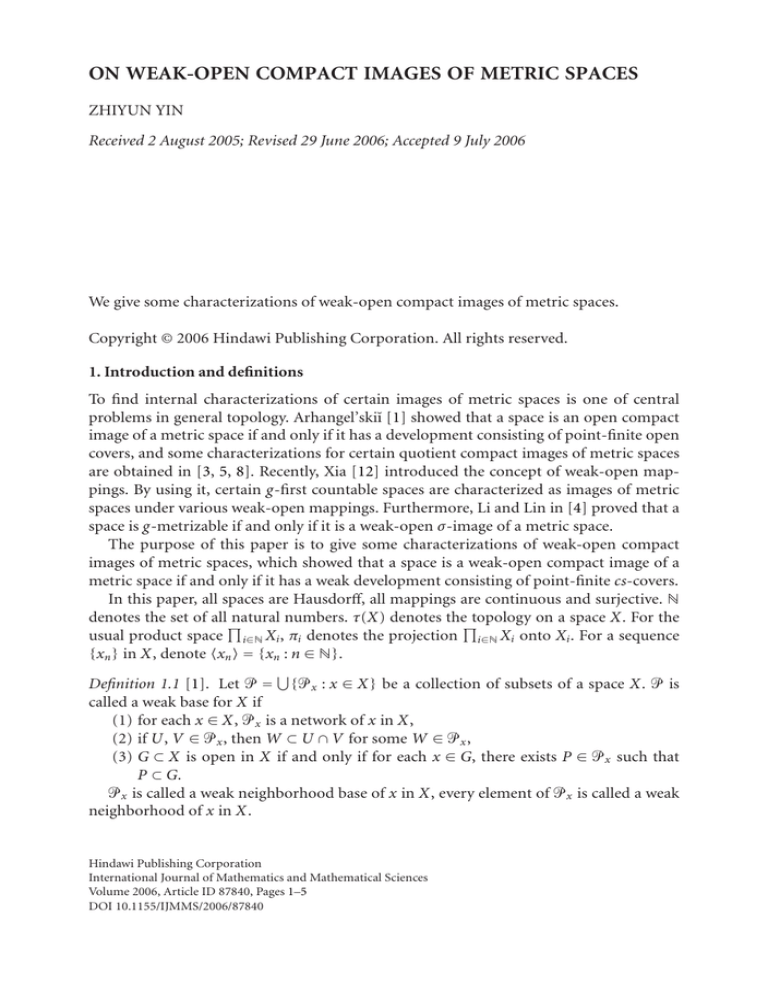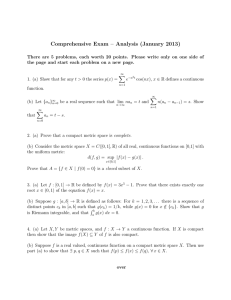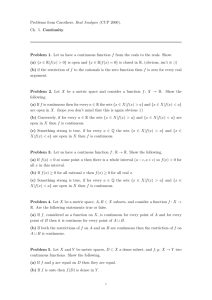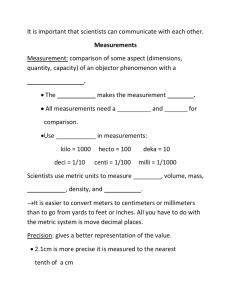
ON WEAK-OPEN COMPACT IMAGES OF METRIC SPACES
ZHIYUN YIN
Received 2 August 2005; Revised 29 June 2006; Accepted 9 July 2006
We give some characterizations of weak-open compact images of metric spaces.
Copyright © 2006 Hindawi Publishing Corporation. All rights reserved.
1. Introduction and definitions
To find internal characterizations of certain images of metric spaces is one of central
problems in general topology. Arhangel’skiı̆ [1] showed that a space is an open compact
image of a metric space if and only if it has a development consisting of point-finite open
covers, and some characterizations for certain quotient compact images of metric spaces
are obtained in [3, 5, 8]. Recently, Xia [12] introduced the concept of weak-open mappings. By using it, certain g-first countable spaces are characterized as images of metric
spaces under various weak-open mappings. Furthermore, Li and Lin in [4] proved that a
space is g-metrizable if and only if it is a weak-open σ-image of a metric space.
The purpose of this paper is to give some characterizations of weak-open compact
images of metric spaces, which showed that a space is a weak-open compact image of a
metric space if and only if it has a weak development consisting of point-finite cs-covers.
In this paper, all spaces are Hausdorff, all mappings are continuous and surjective. N
denotes the set of all natural numbers. τ(X) denotes thetopology on a space X. For the
usual product space i∈N Xi , πi denotes the projection i∈N Xi onto Xi . For a sequence
{xn } in X, denote xn = {xn : n ∈ N}.
Definition 1.1 [1]. Let ᏼ = {ᏼx : x ∈ X } be a collection of subsets of a space X. ᏼ is
called a weak base for X if
(1) for each x ∈ X, ᏼx is a network of x in X,
(2) if U, V ∈ ᏼx , then W ⊂ U ∩ V for some W ∈ ᏼx ,
(3) G ⊂ X is open in X if and only if for each x ∈ G, there exists P ∈ ᏼx such that
P ⊂ G.
ᏼx is called a weak neighborhood base of x in X, every element of ᏼx is called a weak
neighborhood of x in X.
Hindawi Publishing Corporation
International Journal of Mathematics and Mathematical Sciences
Volume 2006, Article ID 87840, Pages 1–5
DOI 10.1155/IJMMS/2006/87840
2
On weak-open compact images of metric spaces
Definition 1.2. Let f : X → Y be a mapping.
(1) f is called a weak-open mapping [12], if there exists a weak base Ꮾ = ∪{Ꮾ y : y ∈
Y } for Y , and for each y ∈ Y , there exists x y ∈ f −1 (y) satisfying the following
condition: for each open neighborhood U of x y , B y ⊂ f (U) for some B y ∈ Ꮾ y .
(2) f is called a compact mapping, if f −1 (y) is compact in X for each y ∈ Y .
It is easy to check that a weak-open mapping is quotient.
Definition 1.3 [2]. Let X be a space, and P ⊂ X. Then the following hold.
(1) A sequence {xn } in X is called eventually in P, if the {xn } converges to x, and there
exists m ∈ N such that {x} ∪ {xn : n ≥ m} ⊂ P.
(2) P is called a sequential neighborhood of x in X, if whenever a sequence {xn } in X
converges to x, then {xn } is eventually in P.
(3) P is called sequential open in X, if P is a sequential neighborhood at each of its
points.
(4) X is called a sequential space, if any sequential open subset of X is open in X.
Definition 1.4 [7]. Let ᏼ be a cover of a space X.
(1) ᏼ is called a cs-cover for X, if every convergent sequence in X is eventually in some
element of ᏼ.
(2) ᏼ is called an sn-cover for X, if every element of ᏼ is a sequential neighborhood
of some point in X, and for any x ∈ X, there exists a sequential neighborhood P
of x in X such that P ∈ ᏼ.
Definition 1.5 [7]. Let {ᏼn } be a sequence of covers of a space X.
(1) {ᏼn } is called a point-star network for X, if for each x ∈ X, st(x,ᏼn ) is a network of x in X.
(2) {ᏼn } is called a weak development for X, if for each x ∈ X, st(x,ᏼn ) is a weak
neighborhood base for X.
2. Results
Theorem 2.1. The following are equivalent for a space X.
(1) X is a weak-open compact image of a metric space.
(2) X has a weak development consisting of point-finite cs-covers.
(3) X has a weak development consisting of point-finite sn-covers.
Proof. (1)⇒(2). Suppose that f : M → X is a weak-open compact mapping with M a
metric space. Let {ᐁn } be a sequence consisting of locally finite open covers of M such
that ᐁn+1 is a refinement of ᐁn and st(K,ᐁn ) forms a neighborhood base of K in M for
each compact subset K of M (see [7, Theorem 1.3.1]). For each n ∈ N, put ᏼn = f (ᐁn ).
Since f is compact, then {ᏼn } is a point-finite cover sequence of X.
If x ∈ V with V open in X, then f −1 (x) ⊂ f −1 (V ). Since f −1 (x) compact in M, then
st( f −1 (x),ᐁn ) ⊂ f −1 (V ) for some n ∈ N, and so st(x,ᏼn ) ⊂ V . Hence st(x,ᏼn ) forms
a network of x in X. Therefore, {ᏼn } is a point-star network for X.
We will prove that every ᏼk is a cs-cover for X. Since f is weak-open, there exists
a weak base Ꮾ = ∪{Ꮾx : x ∈ X } for X, and for each x ∈ X, there exists mx ∈ f −1 (x)
Zhiyun Yin 3
satisfying the following condition: for each open neighborhood U of mx in M, B ⊂ f (U)
for some B ∈ Ꮾx .
For each x ∈ X and k ∈ N, let {xn } be a sequence converging to a point x ∈ X. Take
U ∈ ᐁk with mx ∈ U. Then B ⊂ f (U) for some B ∈ Ꮾx . Since B is a weak neighborhood of x in X, then B is a sequential neighborhood of x in X by [6, Corollary 1.6.18],
so f (U) ∈ ᏼk is also. Thus {xn } is eventually in f (U). This implies that each ᏼk is a
cs-cover for X. Since f (U) is a sequential neighborhood of x in X, then st(x,ᏼk ) is also.
Obviously, X is a sequential space. So st(x,ᏼk ) is a weak neighborhood base of x in X.
In words, {ᏼn } is a weak development consisting of point-finite cs-covers for X.
(2)⇒(3). By Theorem A in [5], X is a sequential space. It suffices to prove that if ᏼ is
a point-finite cs-cover for X, then some subset of ᏼ is an sn-cover for X. For each x ∈ X,
denote (ᏼ)x = {Pi : i ≤ k}, where (ᏼ)x = {P ∈ ᏼ : x ∈ P }. If each element of (ᏼ)x is not
a sequential neighborhood of x in X, then for each i ≤ k, there exists a sequence {xin }
converging to x such that {xin } is not eventually in Pi . For each n ∈ N and i ≤ k, put
yi+(n−1)k = xin , then { ym } converges to x and is not eventually in each Pi , a contradiction.
Thus there exists Px ∈ ᏼ such that Px is a sequential neighborhood of x in X. Put Ᏺ =
{Px : x ∈ X }, then Ᏺ is an sn-cover for X.
(3)⇒(1). Suppose {ᏼn } is a weak development consisting of point-finite sn-covers for
X. For each i ∈ N, let ᏼi = {Pα : α ∈ Λi }, endow Λi with the discrete topology, then Λi is
a metric space. Put
M = α = (αi ) ∈
i∈N
Λi : Pαi forms a network at some point xα in X ,
(2.1)
and endow M with the subspace topology induced from the usual product topology of the
collection {Λi : i ∈ N} of metric spaces, then M is a metric space. Since X is Hausdorff,
xα is unique in X. For each α ∈ M, we define f : M → X by f (α) = xα . For each x ∈ X
and i ∈ N, there exists αi ∈ Λi such that x ∈ Pαi . From {ᏼi } being a point-star network
for X, {Pαi : i ∈ N} is a network of x in X. Put α = (αi ), then α ∈ M and f (α) = x. Thus
f is surjective. Suppose α = (αi ) ∈ M and f (α) = x ∈ U ∈ τ(X), then there exists n ∈ N
such that Pαn ⊂ U. Put
V = β ∈ M : the nth coordinate of β is αn .
(2.2)
Then α ∈ V ∈ τ(M), and f (V ) ⊂ Pαn ⊂ U. Hence f is continuous.
For each x ∈ X and i ∈ N, put
Bi = αi ∈ Λi : x ∈ Pαi ,
(2.3)
= (αi ) ∈ i∈N Bi , then Pαi is a network of
then i∈N Bi is compact in i∈N Λi . If α f
(α)
= x. Hence i∈N Bi ⊂ f −1 (x); If α = (αi ) ∈ f −1 (x), then
x inX. So α ∈ M and
x ∈ i∈N Pαi , so α ∈ i∈N Bi . Thus f −1 (x) ⊂ i∈N Bi . Therefore, f −1 (x) = i∈N Bi . This
implies that f is a compact mapping.
4
On weak-open compact images of metric spaces
We will prove that f is weak-open. For each x ∈ X, since every ᏼi is an sn-cover for X,
From {ᏼi }
then there exists αi ∈ Λi such that Pαi is a sequential neighborhood of x in X.
a point-star network for X, Pαi is a network of x in X. Put βx = (αi ) ∈ i∈N Λi , then
βx ∈ f −1 (x).
Let {Umβx } be a decreasing neighborhood base of βx in M, and put
Ꮾx = f Umβx : m ∈ N ,
Ꮾ=
Ꮾx : x ∈ X ,
(2.4)
then Ꮾ satisfies (1), (2) in Definition 1.1. Suppose G is open in X. For each x ∈ G, from
βx ∈ f −1 (x), f −1 (G) is an open neighborhood of βx in M. Thus Umβx ⊂ f −1 (G) for some
m ∈ N, so f (Umβx ) ⊂ G and f (Umβx ) ∈ Ꮾx . On the other hand, suppose G ⊂ X and for
x ∈ G, there exists B ∈ Ꮾx such that B ⊂ G. Let B = f (Umβx ) for some m ∈ N, and let
{xn } be a sequence converging to x in X. Since Pαi is a sequential neighborhood of x in
X for each i ∈ N, then {xn } is eventually in Pαi . For each n ∈ N, if xn ∈ Pαi , let αin = αi ; if
xn ∈ Pαi , pick αin ∈ Λi such that xn ∈ Pαi n . Thus there exists ni ∈ N such that αin = αi for
all n > ni . So {αin } converges to αi . For each n ∈ N, put
βn = (αin ) ∈
Λi ,
(2.5)
i∈N
then f (βn ) = xn and {βn } converges to βx . Since Umβx is an open neighborhood βx in
M, then {βn } is eventually in Umβx , so {xn } is eventually in G. Hence G is a sequential
neighborhood of x. So G is sequential open in X. By X being a sequential space, G is open
in X. This implies Ꮾ is a weak base for X.
By the idea of Ꮾ, f is weak-open.
We give examples illustrating Theorem 2.1 of this note.
Example 2.2. Let X be the Arens space S2 (see [6, Example 1.8.6]). It is not difficult to
see that the space is a weak-open compact image of a metric space. But X is not an open
compact image of a metric space, because X is not developable. Thus the following holds.
A weak-open compact image of a metric space is not always an open compact image
of a metric space.
Example 2.3. Let Y be the weak Cauchy space in [10, Example 2.14(3)]. By the construction, Y is a quotient compact image of a metric space. But Y is not Cauchy, Y is not a
weak-open compact image of a metric space by Theorem 2.1. Thus the following holds:
A quotient compact image of a metric space is not always a weak-open compact image
of a metric space.
Acknowledgments
This work is supported by the NSF of Hunan Province in China (no. 05JJ40103) and the
NSF of Education Department of Hunan Province in China (no. 03C204).
Zhiyun Yin 5
References
[1] A. V. Arhangel’skiı̆, Mappings and spaces, Russian Mathematical Surveys 21 (1966), no. 4, 115–
162.
[2] S. P. Franklin, Spaces in which sequences suffice, Fundamenta Mathematicae 57 (1965), 107–115.
[3] Y. Ikeda, C. Liu, and Y. Tanaka, Quotient compact images of metric spaces, and related matters,
Topology and Its Applications 122 (2002), no. 1-2, 237–252.
[4] Z. Li and S. Lin, On the weak-open images of metric spaces, Czechoslovak Mathematical Journal
54 (2004), no. 2, 393–400.
[5] S. Lin, On the quotient compact images of metric spaces, Advances in Mathematics 21 (1992),
no. 1, 93–96.
, Generalized Metric Spaces and Mappings, Chinese Scientific, Beijing, 1995.
[6]
, Point-Countable Coverings and Sequence-Covering Mappings, Chinese Distinguished
[7]
Scholars Foundation Academic Publications, Chinese Scientific, Beijing, 2002.
[8] S. Lin, Y. C. Zhou, and P. F. Yan, On sequence-covering π-mappings, Acta Mathematica Sinica 45
(2002), no. 6, 1157–1164.
[9] F. Siwiec, On defining a space by a weak base, Pacific Journal of Mathematics 52 (1974), 233–245.
[10] Y. Tanaka, Symmetric spaces, g-developable spaces and g-metrizable spaces, Mathematica Japonica
36 (1991), no. 1, 71–84.
[11] Y. Tanaka and Z. Li, Certain covering-maps and k-networks, and related matters, Topology Proceedings 27 (2003), no. 1, 317–334.
[12] S. Xia, Characterizations of certain g-first countable spaces, Advances in Mathematics 29 (2000),
no. 1, 61–64.
Zhiyun Yin: Department of Information, Hunan Business College, Changsha,
Hunan 410205, China
E-mail address: yzy8846@163.com





